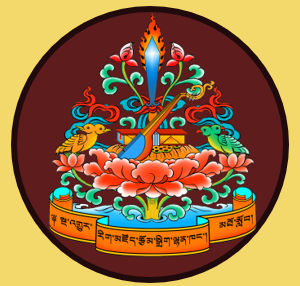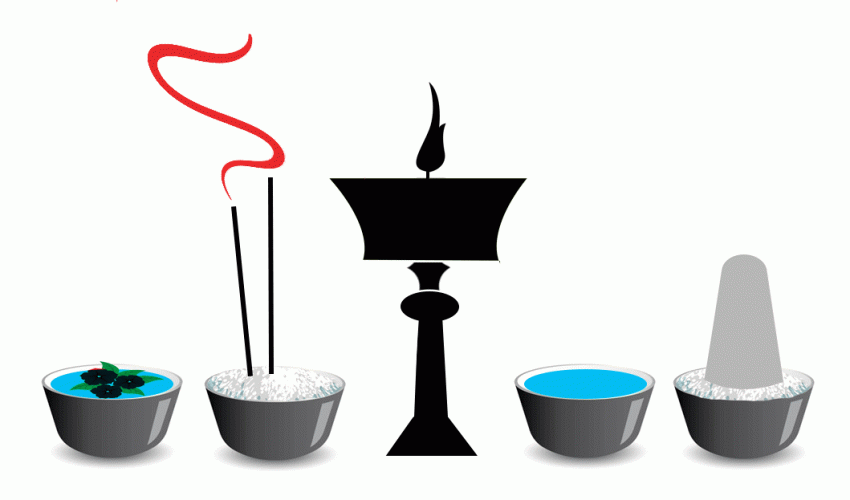What are known as the “five offerings” in Tibetan is choepa–na-nga. They comprise one of the “seven practices” 1 and provide a method for accumulating merit and reducing attachment towards worldly pleasure. Though making offerings can be classified into many subdivisions, here it is classified into five: the offering of flowers, incense, butter lamps, scented water, and ritual cakes (direct translation from Tibetan). Incense, butter lamp and ritual cake offerings, in the broader sense, means offering pleasant aromas, light and feasts respectively.
Flower offerings are made to beautify the crown of the buddhas and bodhisattvas, pleasant aromas to satisfy their olfactory sense, light to satisfy their eyes, scented water as a sweet perfume for their body, and feasts to satisfy their taste.
There are two ways of offering them: offering through visualisation and actual offering.
To make the five offerings through visualisation, one must first invoke bodhichitta, and then visualise buddhas and bodhisattvas magnificently seated on their respective thrones.
Then to make an offering of flowers, one should visualise like this: The world is filled with beautiful divine flowers, mandarava, the most beautiful flowers of the human realm, lotuses and utpala, and all the beautiful flowers with a sweet aroma of the nagas. Toss them into the sky as an offering to the bodhisattvas. From each of these flowers countless beautiful flowers appear magically. They are then carried away by a gust of wind as an offering to the buddhas in the ten directions. Offer mesmerizing garlands of beautiful flowers and other lovely patterns made from the flowers to them. Then make an aspiration like this: “As a result of this, may all the sentient beings be endowed with a ‘blossom’ such as the seven qualities of enlightenment.”
To make the offering of pleasant aromas, one should visualise like this: All the places in the ten directions are filled with different types of tantalizing aromas like the sweet smell of sandal, gabur, black agaru and others that are pleasing. The sweet-smelling incense of juniper and others fill up the whole place. It is then carried away by the wind to the buddhas and bodhisattvas. They become gladdened by this offering. Then make an aspiration like, “May this aroma cleanse the suffering of all beings, and as a result of this, may all beings be endowed with the sweet aroma of discipline.”
To make the offering of light, one should visualise like this: All the bodies of water in this world are filled with golden lotuses that are arranged in perfect straight lines. The pistil of every lotus is made of crystals and other jewels, which shine forth rays of light into all the parts of the world, even at night. Then, there is a butter lamp as large as the “triple world system”, with a wick the size of Mount Meru, and the butter in the lamp is as voluminous as the ocean. It emits rays of five colours which spread in the sky. Offer these to the buddhas and bodhisattvas and make an aspiration like this: “May this light dispel the ignorance of all sentient beings, and as a result of this, may the wisdom light of the buddhas arise in us.”
To make the offering of scented water one should visualise like this: The land is adorned by varieties of gems and jewels, and is flat, even, soft and smooth. It is covered with a thin layer of scented water. On the scented water are beautiful flowers floating on the surface. Offer this to the buddhas and bodhisattvas and aspire like this: “As a result of this, may bodhichitta, as stable as this land, arise in all sentient beings.”
To make the offering of a feast, visualise like this: Delicious preparations; clean, juicy and tasty fruits and vegetables all arranged in a pleasing manner; and the nectar of the gods and clean water with eight distinctive qualities, contained in elegant cups, are all offered to the buddhas and bodhisattvas. Then make an aspiration like this: “As a result of this, may supreme, unwavering concentration arise in all sentient beings.”
To make these offerings in a practical way, one must first clean the bowls in which they are to be arranged (because in Tibetan culture, they are normally offered in bowls). Then fill the first and fourth bowls with clean scented water, and fill the rest of the bowls with clean rice grains. In the first bowl of water, put some beautiful flowers on it and let them float. On the rice grains of the second, third and fifth bowls, place incense sticks, a butter lamp and a ritual cake, respectively; the fourth bowl can be left as it is. Then arrange them neatly on the first level of a shrine.
After finishing this, if one can, then one should expand one’s simple offering through the visualisations mentioned above, or one can directly make aspirational prayers. But it is necessary to invoke bodhichitta first and complete the action with dedication prayers.
By Passang Gyaltsen
Final Year, NNI



